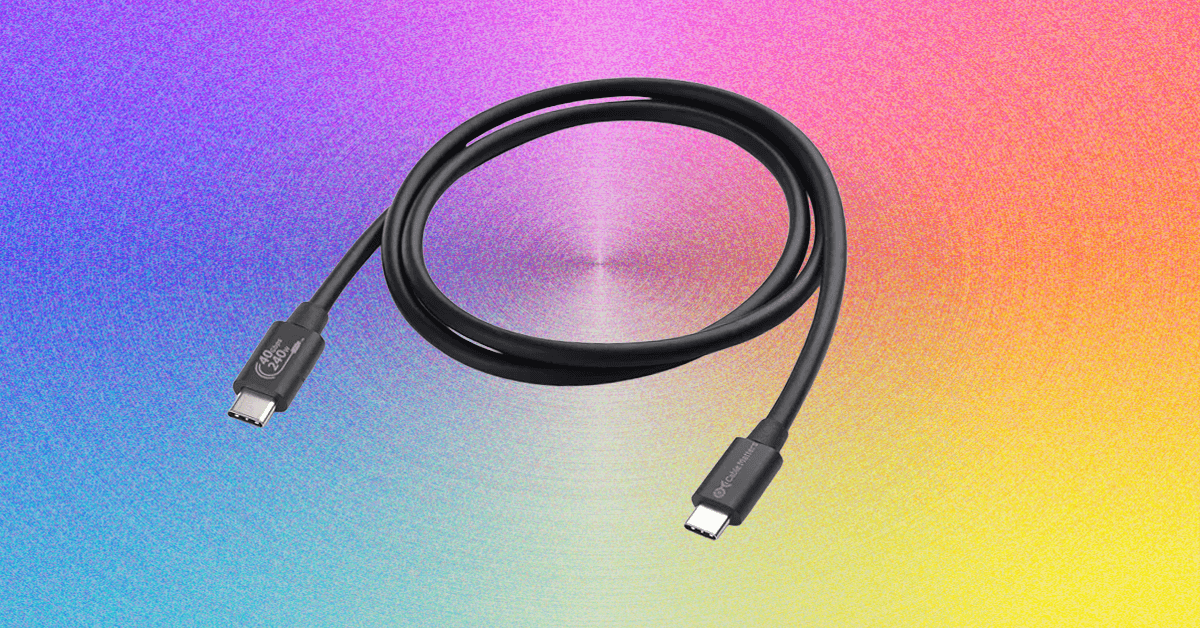Tech
The Best USB-C Cables for Your Phone, Tablet, or Laptop

More USB-C Cables We Have Tested
There are so many cables out there, and plenty of solid options did not make the cut. Here are a few I’ve tested and liked.
Photograph: Simon Hill
Twelve South PowerCord for $30: While I don’t think we want to go back to permanently attached cables and power adapters, they offer a simplicity that could be useful for some folks or situations. The PowerCord from Twelve South is thick and durable-feeling, with a tangle-resistant woven (4- or 10-foot) USB-C cable attached to a compact 30-watt (Power Delivery) wall plug.
EcoFlow Rapid Pro for $21: Kept out of a place above by Anker’s cables, this durable charging cable from EcoFlow is a solid choice if you want fast charging, since it can supply 240 watts. It also has tough metal ends, a lovely woven finish, and comes with a cable tie.
Nomad Chargekey for $29 and USB-C Cable for $25: The Chargekey is a handy wee addition to your keyring with 12 cm of braided cable capable of delivering 240 watts and up to 10 Gbps data transfer, though it can be a little awkward to use. I also tried Nomad’s new Kevlar-reinforced USB-C cable, which is also 240 W but only has 480 Mbps data transfer. It feels durable with metal ends and braided cable, but you can get more capable cables for less.
QDOS PowerMotion Ultra for £40: This USB 4.0 cable is a solid alternative to our top picks for folks in the UK, combining up to 240-watt charging with data transfer speeds up to 40 Gbps. It is relatively thick, feels durable, and comes with a lifetime warranty. I like the braided nylon finish and color-matched cable tie. I also tried the QDOS Powerloop (£20), a handy wearable charging cable that doubles as a lanyard strap. It’s thick, woven, and durable, with screw-off ends that reveal a USB-C cable capable of supplying 60 watts of power and 480 Mbps of data.
Chargeasap Connect Pro for $60: Magnetic tip cables can be handy for kids and folks with dexterity issues. The idea is you stick the relevant tip in your device and then attach the cable magnetically when you need to charge. This one also has an LED display to show real-time power usage. It works best if you leave the tips in your devices, but that means they can’t be charged by regular cables, and the tips are very easy to lose if you remove them. Performance-wise, it’s a standard 100-watt charging cable.
Krafted Connex for £30: I like the idea of a Swiss Army Knife–style charging cable keyring, but the execution here is flawed. It does offer USB-A, USB-C, Lightning, and MicroUSB, but the flip-out plugs don’t have any cable attached, so they are not very adjustable, making it tough to plug into some ports. The Rolling Square InCharge X 6-in-1 Cable above is the same price and works far better.
Scosche Strikeline Premium USB-C Cable for $25: This braided cable comes in various lengths all the way up to the 10-foot cable I tested, and it’s a good alternative to our best long cable above if data transfer is more important to you than charging speed because it offers 5 Gbps data speeds, but only 60 watts for charging.
Ugreen Uno USB-C Cable for $10: I love the smiley-faced Uno line from UGreen, but I assumed the display on this cable would show the charging rate. It does not. It just displays smiley eyes when charging and changes when fully charged. I tested the 6.6-foot cable, but it also comes in 1.6-, 3.3-, or 10-foot lengths. It feels durable and is reasonably priced, but it is rated at a very ordinary 100 watts and 480 Mbps.
Native Union Pocket Cable for $30: This wee braided USB-C to USB-C cable is perfect for slipping on a keyring to ensure you are never caught without a cable. It’s a nice design with braided cables, but you only get around 7 inches, and it maxes out at 60 watts. It is built to last from recycled materials, USB-IF certified, and comes with a lifetime warranty.
Caudabe ChargeFlex for $25: This was our Lightning recommendation, and it’s still good, but the price has gone up and there’s no need to spend this much. It is a thick braided cable reinforced with Kevlar for durability. There is a leather clip you can use for cable management, and the ridged finish on the connectors makes them easy to grip when unplugging.
Cable Matters Gen 2 USB-A to USB-C cable for $10: This is a good alternative to our pick above if you want faster data transfer speeds (it maxes out at 10 Gbps), but it is limited to 15 watts for charging.
Bluebonnet Eco-Friendly Charging Cable for $25: Bluebonnet (an Austin-based studio named after the Texas state flower) made this cable from naturally biodegradable wheat straw. It promises 50,000 plus bends and uses plastic-free packaging. I love the dappled blue finish and the cream ends. They make it easy to pick this cable out of the crowd. It’s nothing special performance-wise, offering up to 60-watt charging and 480 Mbps data transfer.
RUGD Rhino Power USB-C to USB-C for £11: This is a solid option for folks in the UK seeking a tough cable. It has a braided nylon finish and can withstand a minimum of 100 kilograms of tension and 100,000 bends. It can also deliver up to 60 watts.
Casetify Powerthru USB-C to Lightning Cable for $25: This tough, braided cable comes in some fun colors (most notably cotton candy), but it’s kinda pricey for a 100-watt charging cable.
Iniu Braided USB-C Cable for $6: This is a cheap, 6.6-foot USB-C to USB-C charging cable that tops out at 100 watts. Data transfer is only 480 Mbps. One end lights up green when it’s charging.
Lindy USB 3.2 Type C to C Cable for $23: These active cables are suitable for hooking monitors up to your computer, and they support up to 8K at 60 Hz and 4K at 120 Hz. They also support DisplayPort 1.4. I tested the longer 3- and 5-meter variants that max out at 60 watts for Power Delivery and 10 Gbps for data (but they’re out of stock). The shorter cable linked here can go up to 20 Gbps. They work well and feel durable, but they’re a bit pricey.
Satechi USB-C to USB-C Charging Cable for $20: Gear from Satechi always has a classy look, and its braided nylon cables are no exception. This one is 6.5 feet, has a Velcro strap, and is capable of 100-watt charging, with support for PD and QC. Sadly, data transfer is limited to 480 Mbps.
Plugable Thunderbolt 4 Transfer Cable for $70: This active Thunderbolt 4 USB-C to USB-C cable matches our top pick with support for 100-watt charging and data transfers up to 40 Gbps. It is 6.6 feet long and comes with a two-year warranty.
Belkin Boost Charge USB-C for $10: This cable maxes out at 12 watts and 480 Mbps. The basic PVC finish is the cheapest, but you can opt for braided nylon too; both come in black or white at 3.3 or 6.6 feet. These cables are USB-IF certified and work as advertised (I’ve been using one in the car for the last few months).
Power up with unlimited access to WIRED. Get best-in-class reporting and exclusive subscriber content that’s too important to ignore. Subscribe Today.
Tech
I Keep Cooking Thanksgiving! Here’s the Best Holiday Meal Delivery

Making a full Thanksgiving feast for guests can be daunting, for some perhaps even terrifying. The world, and especially Hallmark movies, is full of holiday disaster stories: burnt turkeys, failed desserts, steamed hams. But I’m not bragging when I say that the first Thanksgiving dinner I prepared for my extended family—a little early, this year—was an unmitigated success.
My aunt couldn’t stop talking about the black pepper in the biscuits and the sage on the carrots. My uncle went in for the turkey and the apple-sausage stuffing. My father didn’t speak at all, unless prompted. He just ate and ate. This was a compliment.
But of course, I had cheated. I had ordered my Thanksgiving in the mail—one of the new breed of Thanksgiving meal kits.
The meal was genuinely home-cooked, of course, prepared mostly from scratch. But the entire seven-platter feast—its ingredients and recipes—had arrived two days before, in a box large enough to house a primal cut of beef. It was Thanksgiving in a box: a $200 “Chef’s Table Thanksgiving” meal kit available from sister meal delivery plans Sunbasket and Gobble.
The spread from Sunbasket was vast and generous. The table contained a nearly 3-pound roast of turkey, mounds of mashed potato, pebbled cranberry compote, roasted carrots dressed in miso-sage butter, brussels sprouts dappled with pecorino romano and pancetta, an endless platter of fennel-apple-sausage-stuffing, Gruyère black-pepper biscuits caked more than an inch tall, a tureen of deep brown turkey gravy, a ginger apple crisp waiting in the wings.
Sunbasket is among a new bounty of meal kit companies that aim to ease the stress of the holidays by doing the planning and the shopping for you—big meal boxes tailor-made for those who still want to make a home-cooked meal but for whom the prospect of planning a vast and complicated feast is prohibitive. In fact, two weeks later I cooked another Thanksgiving meal from Blue Apron, this time for my sister’s family.
Here was my experience with Sunbasket and Blue Apron—and some of the other Thanksgiving meal delivery options to get your whole Thanksgiving meal delivered to your home.
Want meal kits for more everyday occasions? See WIRED’s guides to the best meal delivery services, and the best plant-based meal delivery kits.
The Blue Apron à la Carte Thanksgiving (and Holiday) Meal Kit
Available till December 29. Order by November 19 to ensure delivery by Thanksgiving.
Blue Apron, one of the OG meal kits in the US, has undergone a wholesale transformation this year. One of the biggest changes is that subscriptions are no longer required, and à la carte meal ordering is possible—indeed, it’s now my favorite no-subscription meal kit offering. What this means is that for this Thanksgiving, you can order individual Thanksgiving recipe kits to prep fresh at home, without ever setting foot in a crowded grocery store.
That means roasted grape and goat cheese salad ($12), a big ol’ turkey breast with gravy and cranberry sauce ($50), rosemary herb stuffing ($15), a truly excellent casserole worth of truffle-oiled Southern mac and cheese ($20), almond apple crumb pie ($15), brown butter mashed potatoes ($8), challah rolls with maple ($8) and roasted brussels sprouts with pistachios, ($10). I made all of these recipes for my sister’s family and our parents, a little early this year—and it was a surprisingly delicious feast fit for at least eight people. Probably even 10, if you add an extra order of mashed potatoes.
Tech
The Best Binoculars Will Help You Find the Ivory Billed Woodpecker

You get good magnification, with a waterproof (IPX7 rating) and fogproof design in a lightweight package (11.8 ounces). These also have two things that specifically make them great for kids: rugged construction and a nice, rubberized grip. I can’t tell you how many trees and rocks these have bashed into while around my son’s neck, and they’re still as good as new.
Stargazing Binoculars
When you think stargazing you probably think telescopes, but binoculars can work too, especially larger, higher-magnification models like these Celestron Skymasters. The first thing to know is that these are huge—most of the time you’ll want to use them with a tripod, which is not included in the price (they do include an adapter, which I used to put them on a photo tripod, which worked fine). The Porro prism design (see above), with 15x magnification and 70mm objective lenses, make these nice and bright, perfect for getting good views of the moon. They also work for larger clusters and nebulae. They do work for birding as well, but it’s more like using a spotting scope. They’re nice for digiscoping, though if you’re viewing something reasonably stationary, like water birds.
As with all Celestron binos there’s a nice big, smooth focusing knob, and they also have long eye relief which makes them easy to use with glasses. There is a fair bit of chromatic aberration, especially with bright stars or the moon, but I didn’t find it distracting. In fact, for the price, these provide surprisingly great views.
Image-Stabilizing Binoculars
Image-stabilized binoculars use electronics to smooth out your view, similar to what action cams do to get rid of jittery video. There are quite a few models out there, and we are still testing, but here are a few that have stood out from the pack so far.
Image-stabilized binoculars tend to be expensive, but Canon has quite a few budget models worth considering. They’re simple to use. You just tap the button on top for five minutes of stabilization, or tap again to turn it off sooner. The tech detects your movement and adjusts for it optically, in real-time. The Canon 8×20 IS, its smallest, is doubly pocket-friendly: They’re surprisingly affordable and fit in a large pocket. At 15-ounce plus battery, they won’t weigh you down.
The 8X magnification is good for wildlife and sports, as is the 10X magnification of the only slightly larger Canon 10×20 IS. The 6.6-degree field of view is narrow but wide enough for most situations.
Tech
Ransomware resilience may be improving in the health sector | Computer Weekly

In a possibly encouraging sign that cyber messaging is cutting through among healthcare providers, the sector appears to be becoming increasingly resilient to ransomware and cyber extortion, with fewer victims experiencing data encryption, fewer paying up and average time to recovery dropping according to a new Sophos report.
Based on global data collected by Vanson Bourne for a wider study, Sophos found that that this year, just 36% of victims in the healthcare industry paid a ransom, down from 61% in 2022, and over half of those that paid handed over less than what was demanded of them.
Demands from ransomware gangs also plummeted during the observed period, down 91% to $343,000 (£260,800) on average this year, with average payments dropping from $1.47m to just $150,000, the lowest of any sector reported in the wider dataset.
The mean cost of recovery – excluding any ransoms – was also down by 60% to $1.02m. And 58% of healthcare respondents said they recovered within a week, a strong improvement from 21% last year.
“It’s … encouraging to see signs of stronger resilience. In the study, nearly 60% of providers reported they recovered within one week, up from just 21% last year, which reflects real progress in preparedness and recovery planning. In a sector where downtime directly affects patient care, faster recovery is critical, but prevention remains the ultimate goal,” said Alexandra Rose, director at the Sophos Counter Threat Unit (CTU) – formerly a Secureworks unit.
However, improvement against some metrics should not be taken as a sign that the ransomware ecosystem is dwindling or the threat landscape becoming any less volatile; ransomware remains as pervasive a threat as ever and the healthcare sector is no more or less immune than any other.
“Healthcare continues to face steady and persistent ransomware activity. Over the past year, Sophos X-Ops identified 88 different groups targeting healthcare organisations, showing that even moderate levels of threat activity can have serious consequences,” said Rose.
In the past 12 months, the X-Ops team said that the most prominent ransomware gangs targeting the health industry were Qilin, INC Ransom and RansomHub – which it tracks as Gold Feather, Gold Ionic and Gold Hubbard respectively.
The data also reveal that although data encryption from ransomware has dropped to its lowest level since 2020, with only a third of attacks resulting in this scenario, the proportion of healthcare providers hit by extortion-only attacks, where data is not encrypted but rather stolen and a ransom demanded has tripled to 12% of attacks this year, from 4% a couple of years ago. The Cl0p/Clop gang, which last week claimed to have conducted a ransomware attack against an unspecified NHS body, is a great exponent of this tactic.
Root causes
Sophos’ data also reveal some insight into the root causes of cyber extortion and ransomware attacks in the healthcare industry, finding that for the first time since 2022, exploited vulnerabilities were the most common technical cause, seen in 33% of incidents, overtaking credential-based attacks, which topped the list in 2023 and 2024.
Respondents also described “multiple organisational factors” that contributed to their falling victim to such attacks, with 42% describing a lack of suitably qualified cyber security people or overall capacity, and 41% describing known but unaddressed security gaps.
-

 Tech1 week ago
Tech1 week agoFrom waste to asset: Turning ethanol production CO₂ into jet fuel
-

 Tech3 days ago
Tech3 days agoNew carbon capture method uses water and pressure to remove CO₂ from emissions at half current costs
-

 Politics5 days ago
Politics5 days agoBritish-Pakistani honoured for transforming UK halal meat industry
-

 Sports3 days ago
Sports3 days agoTexas A&M officer scolds South Carolina wide receiver after touchdown; department speaks out
-

 Business3 days ago
Business3 days agoThese 9 Common Money Mistakes Are Eating Your Income
-

 Tech1 week ago
Tech1 week agoSecurity flaws in portable genetic sequencers risk leaking private DNA data
-

 Sports1 week ago
Sports1 week agoSteelers vs. Chargers (Nov 9, 2025) Live Score – ESPN
-

 Fashion5 days ago
Fashion5 days agoAdidas & Patrick Mahomes expand NIL programme with Texas Tech athletes

















-SOURCE-Caramel-Quin.jpg)




